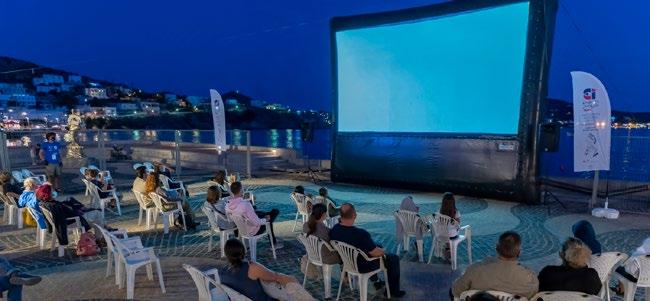
4 minute read
Ελληνικός Οργανισμός Τουρισμού Greek National Tourism Organisation
Tο Διεθνές Φεστιβάλ Κινουμένων Σχεδίων Animasyros 2021 επιστρέφει για 14η χρονιά στη Σύρο, γιορτάζοντας την ελευθερία. Με αφορμή τα 200 χρόνια από την Ελληνική Επανάσταση, το μεγαλύτερο στο είδος του φεστιβάλ στην Ελλάδα και ένα από τα 20 σημαντικότερα παγκοσμίως, αντλεί φέτος έμπνευση από τον αγώνα των Ελλήνων για Ελευθερία και είναι αφιερωμένο στην προσωπική ελευθερία και την προσωπική επανάσταση. Με έδρα την Ερμούπολη, η ετήσια γιορτή του ανιμέισον επιστρέφει στο εμβληματικό Θέατρο Απόλλων και στο Πνευματικό Κέντρο της πόλης, αλλά το καλλιτεχνικό πρόγραμμα του Φεστιβάλ θα «μοιραστεί» και στο θερινό σινεμά Παλλάς αλλά και σε εξωτερικούς χώρους στο νησί της Σύρου: Στην Έπαυλη Τσιροπινά στην Ποσειδωνία, στην Άνω Σύρο, στην Πλατεία του Φοίνικα, στην παραλία της Βάρης (ξενοδοχείο Kamelo) κ.α. Παράλληλα το Animasyros θα διατηρήσει την νέα του μορφή, του «Phygital» που εγκαινιάστηκε πέρυσι με επιτυχία δίνοντας διέξοδο στις δυσκολίες της φυσικής παρουσίας λόγω της πανδημίας. Η ψηφιακή πλατφόρμα με live streaming είναι προσβάσιμη μέσω animasyros.gr/screenings ενώ και οι δράσεις της Αγοράς με το Pitching Forum που διοργανώνεται σε συνεργασία με το παγκοσμίου φήμης Animation Studio Folimage, θα μεταδίδoνται μέσω της ιστοσελίδας του Animasyros, animasyros.gr. Animasyros International Animation Festival returns for the 14th edition in Syros island, celebrating freedom. The largest Animation Festival in Greece and one of the top 20 in the world, this year, on the occasion of the 200th Anniversary of the Greek Revolution, draws inspiration from the words of the emblematic Greek Revolution hero, Theodoros Kolokotronis, “Just like rain, the desire for freedom fell upon us […], and we started the revolution.”, hence dedicating its main theme to Freedom and Revolution. Based in Ηermoupolis, the annual celebration of animation returns to the emblematic Apollo Theatre and the Cultural Centre of the city. However the artistic program of the Festival will be showcased at the Pallas open-air movie theater and outdoor screenings and events on the island of Syros: At the Tsiropinas Mansion in Possidonia, at Ano Syros, in Finikas Square, at the beach of Vari (Kamelo Hotel), etc
Responding to the special conditions prevailing, due to the pandemic of Covid-19, animations gets “Phygital” through a digital live streaming platform. The digital platform of Animasyros 2021 is accessible at animasyros.gr/screenings. The activities of the Festival Agora Pitching Forum, organized in collaboration with the world-famous French Animation Studio Folimage, will broadcasted through animasyros.gr. O Κερδώος – αλλά και Λόγιος - Eρμής, ο θεός των αρχαίων Ελλήνων «δάνεισε» το όνομά του στην Ερμούπολη, την πρωτεύουσα της Σύρου και την πλέον καλοδιατηρημένη νεοκλασική πόλη της Ελλάδας. Το νησί της Σύρου κατοικείται ήδη από τα νεολιθικά χρόνια και διαδραμάτισε σημαντικό ρόλο στην ανάπτυξη του προϊστορικού κυκλαδικού πολιτισμού, το 3.000 π.Χ. Τον 13ο αιώνα, οι Ενετοί έχτισαν τη μεσαιωνική πόλη του νησιού, την Άνω Σύρο και το νησί άρχισε να κατοικείται από καθολικούς. Ο μεσαιωνικός οικισμός μέσα στο κάστρο, στον αριστερό λόφο πάνω από την Ερμούπολη προστάτευε τους κατοίκους, όταν η Σύρος πληττόταν από την πειρατεία. Τα κάτασπρα στενά της με τις πολύχρωμες μπουκαμβίλιες και την τυπική κυκλαδίτικη αρχιτεκτονική συνθέτουν την απόλυτη νησιωτική εικόνα του Αιγαίου, με τον καθολικό ναό του Σαν Τζώρτζη, χτισμένο το 1834, να δεσπόζει στην κορυφή του λόφου. Τον απέναντι λόφο, τον στεφανώνει ο ορθόδοξος ναός της Αναστάσεως, ο οποίος χτίστηκε το 1909 και στα πόδια του ξετυλίγεται το Βροντάδο, η λαϊκή συνοικία με τα αμέτρητα μαρμάρινα σκαλοπάτια που οδηγεί κατηφορίζοντας στα Βαπόρια, την πιο αρχοντική περιοχή της Ερμούπολης, την οποία γέμισαν με εντυπωσιακές νεοκλασικές επαύλεις οι πλούσιοι πρόσφυγες από τη Μικρά Ασία. Το Θέατρο Απόλλων χτίστηκε στα 1862-1864 από τον Ιταλό αρχιτέκτονα Pietro Sampo και αποτέλεσε έμβλημα οικονομικής και πολιτιστικής ανάπτυξης της Ερμούπολης στα μέσα του 19ου αιώνα. Το επιβλητικό κτίριο συνδέεται αρχιτεκτονικά με τέσσερα τουλάχιστον ιταλικά πρότυπα: τη Σκάλα του Μιλάνου (1776), το ανακαινισμένο θέατρο San Carlo της Νάπολης (1816), το ακαδημαϊκό θέατρο στο Castelfranco (1745) και το Teatro della Pergola της Φλωρεντίας (1755). Το Θέατρο σήκωσε για πρώτη φορά αυλαία με την παράσταση Ριγκολέτο του Τζιουζέπε Βέρντι, ενώ εδώ έδωσε την τελευταία της παράσταση στις 24 Μαρτίου 1953 η Μαρίκα Κοτοπούλη.
Advertisement
Ηermoupolis, named after Hermes, the ancient God of commerce, is the capital of Syros island and the best-preserved neoclassical city in Greece. With a population of 13.000 people, it is the largest dwelling of Cyclades.
Syros is inhabited from the Neolithic era and played an important role in the development of the pre-historic Cycladic civilisation, 3.000 B.C. In the 13th century A.D., the Venetians built the island’s medieval city, Ano Syros, while the island was populated by Catholics. The medieval settlement inside the castle, on the left hill above Hermoupolis protected the inhabitants when Syros was hit by piracy. Its whitewashed walls with the colorful bougainvilleas and the typical Cycladic architecture make up the ultimate island image of the Aegean, with the Catholic church of San Giorgio, built in 1834, dominating the top of the hill. The opposite hill is crowned by the Orthodox church of the Resurrection, built in 1909 and at its feet unfolds Vrontados, the folksy neighborhood with its countless marble steps leading down to Vaporia, the most majestic area of Hermoupolis, which was filled with impressive neoclassical villas by the rich refugees from Mikra Asia (Asia Minor).
Apollon Theatre was built in 1862-1864 by Italian architect Pietro Sampo and it became the emblem of economic and cultural development of Hermoupolis during the mid-19th century. The impressive building is related to at least four Italian architectural styles including that of Teatroalla Scala (1776) in Milan, Teatro San Carlo (1816) in Naples, Teatro Academico (1745) in Castelfranco and Teatrodella Pergola (1755) in Florence. The first work to premiere at the Theatre was Rigoletto by Giusepe Verdi and it was here again where Maria Kotopouli gave her last performance on the March 24, 1953.












